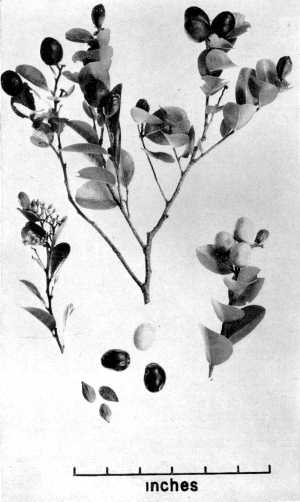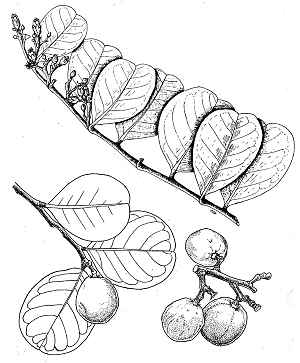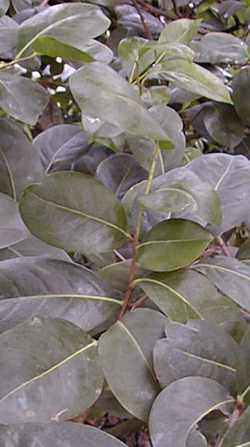USDA: 10-12
Frost Tolerance: Semi-tender in Phoenix, foliage damaged at 30° F (-1° C), serious damage at 25° F (-4° C)
Sun Exposure: Full sun
Origin: Southern Florida, to northern South America, tropical Africa
Growth Habits: Shrub or tree, up to 10 feet tall (3 m) or occasionally much bigger
Watering Needs: Moderate water once established. Needs good drainage. Somewhat salt resistant.
Propagation: Seeds, cuttings

The Cocoplum is indigenous to the coastal regions from southern Florida to northern South America, and to tropical Africa. In form, the cocoplum varies from a low, spreading shrub to a small tree with leathery, dark-green, roundish to obovate leaves.

Cocoplum (Chrysobalanus icaco), U.S.D.A. Drawing, courtesy Hunt Institute
Blooming Habits:
The small white flowers are produced in axillary racemes.
Fruiting Habits:
The mature fruits are 1 to 2 inches in length and ovoid or globular. The thin skin of the fruit varies from pinkish white, to red, to purplish black. The white, cottony pulp adheres to the single large ridged seed and is somewhat insipid in taste. The cocoplum is generally stewed with sugar after the skins have been removed. It can also be used for jelly and jam, and the seeds can be roasted as nuts.
Propagation:
It is usually propagated by seeds but can also be propagated by cuttings.
Desert-Tropicals is dedicated to provide gardening advice, gardening ideas, and information about flower of all kind for landscape and collections.We try to check carefully the identification of the plants on the illustrations as well as the other information from the page, but occasionally errors do occur. if you notice anything that needs to be changed please contact us.Thanks.
© 1998-2020 Philippe Faucon, All Rights Reserved.
